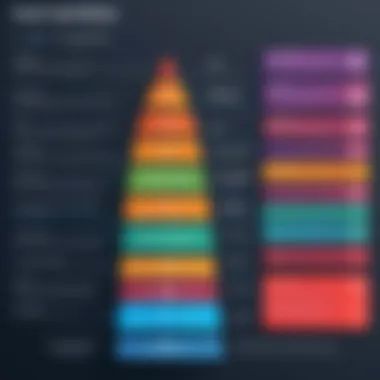Understanding Gravity Zone Pricing: Key Insights for Businesses


Intro
The exploration of pricing structures for cybersecurity solutions, such as Gravity Zone, emerges as a critical step for decision-makers and IT professionals. Customarily, getting a firm grasp on costs directly impacts budgeting and strategy planning for business tech needs. Foreseeing expenses related to any software solution can prevent future challenges and facilitate clear channel conversations between stakeholders.
Understanding the model that Gravity Zone employs can distinguish between merely choosing software versus optimizing it for organizational needs. Thus, this article seeks to unveil the intricacies of Gravity Zone pricing. A clear picture of what financial commitments users can anticipate will help make informed choices. We will cover Industry Overview, key trends, current challenges, emerging technologies, as well as pricing models that align closely with user needs and preferences.
Industry Overview
The landscape of cybersecurity solutions has witnessed significant transformations. With growing digital challenges, organizations are focusing on high-quality software to maintain safety protocols. Therefore, understanding current trends related to cybersecurity becomes vital.
Current Trends in the Industry-specific Software Market
- Enhanced focus on data privacy regulations.
- Increased cloud adoption, leading to potential cybersecurity threats.
- Shift towards integrated security frameworks that combine multiple services under one platform.
- Demand for SaaS solutions is on the rise because of their scalability and flexibility.
Key Challenges Faced by Buyers in the Industry
Navigating the myriad options can be challenging, with risks often increasing uncertainty around investments. Buyers face the following issues:
- Determining which features correspond with actual business needs.
- Balancing cost-effectiveness with advanced capabilities.
- Identifying contractual obligations and hidden costs associated with long-term contracts.
Emerging Technologies Impacting the Industry
Technological advances are continually evolving. Essential innovations include:
- Machine learning algorithms that automate threat detection.
- Artificial Intelligence potentially reducing the manual workload in security management.
- Advances in encryption technologies providing better safeguard of sensitive data.
Top Software Options
As the market expands, Gravity Zone stands as a prominent choice among various cybersecurity solutions. Evaluating other alternatives helps in determining viability.
Review of Leading Software Providers in the Industry
- Gravity Zone by Bitdefender
- CrowdStrike Falcon
- Palo Alto Networks Cortex
- Symantec Endpoint Protection
Feature Comparison of Top Software Solutions
A systematic feature comparison provides clarity on functional abilities. For example:
| Software | Endpoint Protection | Cloud Management | Unified Threat Management | | Gravity Zone | Yes | Yes | Yes | | CrowdStrike Falcon | Yes | Limited | Yes | | Palo Alto Networks Cortex | Yes | Yes | Adequate | | Symantec Endpoint Protection | Yes | Limited | Yes |
Pricing Structures of Different Software Options
Each option carries its pricing structures determined by feature sets:
- Gravity Zone offers tiered pricing depending on the number of endpoints.
- CrowdStrike Falcon follows a per-user subscription model.
- Palo Alto Networks utilizes credits for specific threshold levels of functionality.
- Symantec offers monthly and annual subscriptions with potential volume discount.
Selection Criteria
Choosing the right software is complex, necessitating careful thought. Consulting specific selection criteria is essential.
Important Factors to Consider When Choosing Software
- Suitability to business size and requirements.
- Level of customer support and service provided.
- Review and research of feedback on product performance.
Common Mistakes to Avoid During the Selection Process
Potential errors include:
- Underestimating costs over time.
- Focusing too much on initial purchase price.
- Ignoring vendor reputation and customer support levels.
How to Determine the Right Fit for Your Business Needs
Clearly understanding organizational requirements is crucial. Utilize assessments and potential demonstrations of software to narrow down options.
Implementation Strategies
Adoption strategies for software solutions frame future success.
Best Practices for Smooth Implementation of Software Solutions


- Set clear and structured roadmaps for deployment.
- Encourage stakeholder ownership of the technology.
Integration with Existing Systems and Processes
Respect for existing setups is critical. Analyzing compatibility between chosen cybersecurity solutions and in-house frameworks is crucial.
Training and Support Resources for Successful Deployment
Teams will benefit from support materials, guides, and straightforward customer support lines that reinforce knowledge. This enhances overall satisfaction and productivity.
Future Trends
As technology progresses, operations must remain adaptable to new realities.
Predictions for the Future of the Industry-specific Software Landscape
- Greater emphasis on predictive analytics to foresee cybersecurity threats.
- Continued evolution of adaptability concerning remote work conditions.
Upcoming Technologies Shaping the Industry
New developments such as biometric authentication tools could redefine login measures and data security aspects.
Recommendations for Future-Proofing Your Technology Stack
Diversifying technology choice ensures a well-rounded defense system to remain effective against evolving threats. Partnership opportunities should be explored to enrich the existing tech stack.
Building strategy frameworks around these insights can help in protect businesses very efficiently while adapting to ongoing developments in the security domain.
Prelude to Gravity Zone
Understanding the Introduction to Gravity Zone is critical for navigating the complexities of pricing in a cybersecurity landscape that is constantly evolving. This section delineates what Gravity Zone entails, anchoring its significance within the overarching narrative of the article.
In this comprehensive analysis, discussing Gravity Zone first gives readers clarity on the core functionalities of the solution. It shows how the platform operates and its relevance in today's digital climate. By grasping the nuances in its design and intent, stakeholders can make more evaluated decisions and align their needs to appropriate pricing structures.
What is Gravity Zone?
Gravity Zone is a cybersecurity solution developed by Bitdefender. It centralizes and manages various security services while promoting seamless deployment in cloud, on-premise, or hybrid environments. The tool integrates threat prevention, detection, and response features, designed to safeguard businesses from potential hazards. Through advanced technologies, it offers an adaptive approach against new and evolving threats.
The software categorizes various segments of cybersecurity, making it easier for IT professionals to tailor their defense mechanisms according to specific requirements. The robust management console allows enterprises to maintain oversight of their cybersecurity posture efficiently. Most importantly, the diverse functionality helps in mitigating deployment hurdles which are often encountered within contemporary organizational frameworks.
Significance of Gravity Zone in Cybersecurity
The significance of Gravity Zone resides in its proactive methodologies adapted for modern security challenges. With escalating cyber threats, having a strong security foundation has become non-negotiable for businesses. This nsolution provides methodologies that not only respond to - but also predict and adapt to specific risks.
Some key benefits by employing Gravity Zone include:
- Comprehensive Protection: The platform views threat landscape holistically, covering endpoints, networks, and cloud solutions.
- Scalability: It can easily adapt to the changing size and requirements of a business, providing solutions suitable both for small enterprises and large corporations.
- User-friendly Interface: Provides Ar easy navigation for non-technical professionals while giving detailed insights to IT experts.
Through these features, Gravity Zone exhibits its paramount importance in enterprises employing sophisticated defenses. Understanding its nature is vital for informed decision making, particularly when choosing suitable pricing models and structures to enhance cybersecurity strategies effectively. The ensuing sections will peel back layers of cost implications, competing platforms, and financial wisdom that will further aid potential users in this decision-making process.
"Gravity Zone provides not just protection, but also equips us with the means to predict potential threats, thus evolving with our cybersecurity approach."
Understanding these aspects serves as the gateway to analyzing comprehensive pricing strategies that Gravity Zone proposes.
Overview of Pricing Structures
Understanding the pricing structures associated with Gravity Zone is essential for any organization considering its adoption. Evaluating how these pricing models interact with different user requirements helps decision-makers allocate budgets more effectively. Organizations want to get the best value while ensuring that their cybersecurity needs are fully met.
The concept of pricing structures involves understanding various models available. This information enables businesses to make informed choices based on their specific needs. Ideally, the ideal pricing model aligns financial strategies with tech requirements. A well-optimized pricing structure also reflects market standards, potentially guiding users towards economical and efficient solutions. So, how does Gravity Zone navigate these diverse pricing alternatives?
Insights into Gravity Zone's pricing are crucial in knowing where budgeting might fall short or exceed expectations.
Tiered Pricing Models
Tiered pricing models offer a range of service levels at different price points, catering to varying business sizes and needs within cybersecurity. Clients can select a particular tier that correlates directly with their organization’s scale and complexity. This approach provides flexibility, allowing customers to adjust their expenses based on usage variations.
The primary benefits of tiered pricing models include:
- Cost Efficiency: Clients don’t pay for services they don’t use.
- Scalability: Users can upgrade resources seamlessly as their company grows.
- Customization: Each tier can be tailored to specific requirements and industry needs.


Business leaders often appreciate this compartmentalized approach. Compared to flat-rate systems, tiered models provide more granularity and judicious investment. Ultimately, they permit control over the fluctuating demands of cybersecurity needs.
Flat Rate vs.
Usage-based Pricing
In the world of cybersecurity costing, flat rate and usage-based pricing represents two formidable paths. Flat-rate pricing offers predictability. A steadfast fee covers services regardless of how often they are used. This can ease budgeting concerns for many organizations, especially those leaning towards forecast-based outcomes.
Yet, usage-based pricing exists as a different, dynamic alternative. Organizations pay according to actual service utilization. This is significant because it promotes behavior that minimizes unnecessary spending by enforcing accountability over processes. In circumstances where variability in needs tests the established flat rate, usage-based pricing might produce sharper alignment between service bucks and genuine requirements.
Studies show that flat rate models tend to suit larger enterprises with stable needs while small companies find more relevance in timely adjustments captured by usage-based structures.
Key considerations for businesses deciding between these options should include:
- Predictability of costs
- Historical usage patterns
- Anticipated cybersecurity demand trends
Both models have distinctions punctuating strengths and weaknesses. The choice between these two systems largely depends on individual business contexts and organizational capacity for managing unexpected shifts in demand.
Factors Influencing Gravity Zone Pricing
Understanding the various factors influencing Gravity Zone pricing is essential for organizations making informed purchasing decisions. Several crucial elements contribute to the final pricing framework. Recognizing these components allows decision-makers to anticipate costs better and assess the value received relative to investments. In today's rapidly changing cyber landscape, having clarity on the pricing factors can aid in strategic financial planning.
Business Size and Usage
Business size plays a critical role in determining Gravity Zone prices. Larger organizations may require more extensive coverage, necessitating additional features or licenses. This spectral scope of cover can often drive up initial and ongoing costs.
Conversely, small to medium enterprises might find basic tier options adequate, leading to lower pricing tiers. Likewise, usage greatly influences cost. Increased data usage correlates with more complex server engagements, which generally results in increased fees. Thus, having a clear understanding of business size and expected usage helps companies predict which Gravity Zone model is ideal for their circumstances.
Type of Services Required
The various services integrated into the Gravity Zone package also affect pricing significantly. Organizations might opt for different levels of service based on individual cybersecurity needs. For example, essential services include endpoint protection, threat detection, and response capabilities. Each of these adds to the pricing mechanism differently depending on the level of sophistication or customization required by the user.
Options like advanced web filtering, risk management, or mobile device protection can further augment costs. Hence, organizations should perform a detailed service requirements analysis to ascertain an accurate pricing estimate based on what features are essential versus those that are optional.
Geographical Considerations
Geography is another pivotal factor influencing Gravity Zone pricing. Businesses operating across various regions may encounter price variations influenced by local regulations or market conditions. For instance, different countries might have unique compliance requirements impacting service demands.
Moreover, varying support and infrastructure in specific locales can lead to differences in cost. For multinational companies, consolidating services may provide operational cost savings and a more coherent pricing structure.
Understanding geographical influences enables businesses to evaluate how localized pricing models might suit their distinct contexts.
By examining business size, required services, and geographical influences critically, companies position themselves for smoother engagements with Gravity Zone’s pricing structures. This methodology enables a tailored approach that not only considers financial implications but aligns with overall cybersecurity needs.
Comparing Gravity Zone Prices to Competitors
The examination of Gravity Zone prices in relation to competitors is vital for understanding its positioning in the cybersecurity market. With a growing number of cybersecurity solutions available, decision-makers need to assess how the pricing of Gravity Zone fits against similar offerings. This comparison aids organizations in making informed choices that align with both their security needs and budget constraints.
Comparing prices involves several key elements, enabling the assessment of what an organization gets for its investment.
- Market Relevance: It is important to grasp where Gravity Zone stands when engaging in conversations about options available for cybersecurity. Competitors might offer varying features at different price points, and identifying these can help justify the costs associated with Gravity Zone.
- Budget Efficiency: Analyzing competitors allows firms to gauge the effectiveness of their financial resources. Organizations aim to strike a balance between investment and returns. Understanding where Gravity Zone lies in terms of what clients receive ensures any expenditure aligns with expectations.
- Feature Set Comparison in services: Beyond just pricing, comparing what services come included is equally necessary. Different vendors might market a lower price point, but their offerings may not include the same spectrum of services found in Gravity Zone. Knowing these differences aids in understanding whether cost advantages are misleading or merited by superior service.
Operational insight through comparison can also reflect longer-term financial impact. This segment provides clarity on whether Gravity Zone's pricing is competitive enough to influence some potential customers who prioritize value over basic costs.
Pricing in the Cybersecurity Market
The dynamic nature of the cybersecurity market manifests in its diverse pricing approaches. Providers adopt models that reflect their brand value, customer needs, and operational costs.
Some of the common pricing structure seen include:
- Tiered Pricing: Many cybersecurity solutions, including some of Gravity Zone's competitors, offer tiered pricing. This allows organizations to select a price point that aligns with their specified needs. Higher tiers typically introduce more features, enhanced support options, and exclusions from certain usage limits.
- Flat Rate Models: A few firms present a flat rate priced structure regardless of usage. This simplifies budgeting but may become pricier for smaller firms or organizations that do not utilize the full spectrum of available services.
- Usage-Based Pricing: This model is becoming increasingly prevalent. Pricing fluctuations can yield monthly bills based entirely on actual service usage, shifting cost concerns to users who might not anticipate heavy usage needs.
A sound understanding of these pricing models aids organizations in assessing what they are comfortable investing and helps determine which cybersecurity solution caters to their specific requirements.
Value Proposition of Gravity Zone
The value proposition of Gravity Zone extends beyond baseline pricing. Existing clients highlight it as a pivotal aspect of businesses who entrust their security to the solution.
Some of these value propositions include:


- Comprehensive Protection: Gravity Zone provides robust security measures that encompass threat detection, web and content filtering, and other critical functionalities adapted to user-specific needs.
- User-Centered Design: Participants notice that Gravity Zone's user experience often outmatches many competing products. The emphasis on accessibility and usability surfaces larger value places on cohesive experiences amid security complexities.
- Scalability: The flexibility to adjust services informs organizations about future adjustments, assisting over time without substantial revamping of expenditures.
These are crucial factors organizations evaluate. Ultimately, they denote that Gravity Zone’s pricing can't be viewed in isolation. The broader construct of deliverables plays an equally important role in attaining positive client retention and trust over time. Evaluating costs against both competitors and these added values greatly informs decision-making regarding strategic security investments.
Customer Reviews and Feedback
Customer reviews and feedback provide a vital lens through which potential users can evaluate Gravity Zone. They offer first-hand insights from those who have navigated the similar complexities that new buyers face. Understanding these reviews is essential because they reflect real-world usage, effectiveness, and customer support experiences. For decision-makers and IT professionals, user feedback can influence trust and confidence in the product, steering choices in a crowded market.
Insights from Existing Users
Listening to the voice of users can uncover valuable information that might not be included in formal descriptions or marketing materials. Reviews reveal diverse perspectives that come from unique organizational needs. Many existing users commonly cite reliability and ease of integration as strong selling points of Gravity Zone.
Skilled users often highlight operational efficiency, noting how Gravity Zone adapts to various cybersecurity requirements. Effective customer support is frequently mentioned as invaluable, making assistance accessible and prompt when problems occur.
Challenges, however, are also pointed out. Some reviews indicate that the complexity of certain features might require a learning curve. New users appear to need additional training or resources to utilize the full capacity of Gravity zone. Thus, potential adopters may consider investing in user training from the start.
Common Issues and Resolutions
Regular patterns of issues often become evident when examining user feedback on Gravity Zone. Categorizing these problems assists new users in identifying potential pitfalls and navigating through them. Some common issues noted include installation struggles, compatibility with legacy systems, and performance slowdowns during heavy traffic times.
Solutions to these challenges tend to be part of community discussions and vendor responses. For instance, users recommend closely following installation guidelines to ensure smooth integration. Many have found that re-evaluating system requirements resolves unexpected performance bumps. Customer support networks provide forums where users share tips and solutions, further mitigating common issues.
Ultimately, successfully addressing these problems enhances overall satisfaction for users. Furthermore, a proactive approach towards understanding common issues not only reinforces potential buyers’ confidence but also allows existing users to optimize their systems efficiently.
“The ease with which Gravity Zone integrates into existing systems truly sets it apart, although I had to overcome a few issues with performance at first.”
Evaluating customer reviews through both positive and negative aspects creates a more balanced view for anyone considering this investment in cybersecurity. In this light, it becomes apparent customer sentiments play a crucial role in demystifying the pricing expectations surrounding Gravity Zone.
Long-term Financial Considerations
When evaluating Gravity Zone prices, it is paramount to consider long-term financial implications. Such considerations go beyond initial costs. They play a crucial role in determining overall value and sustainability over time. Businesses typically budget for cybersecurity expenses not as single transactions, but as ongoing investments. This perspective helps align expenses with their overall security strategies. In this context, several key elements arise.
Return on Investment (ROI)
Return on Investment is an essential metric when measuring the financial output of moments spent on cybersecurity solutions. For Gravity Zone users, ROI examines not only the cost incurred through subscription but evaluates the benefits attained in relation to these costs. To understand ROI effectively:
- Identify all relevant costs, including subscription fees, operational expenses, and potential overheads.
- Assess the value derived from improved security posture, which includes reduced breach risks, compliance adherence, and consequent savings from mitigated risks.
- Calculate potential cost savings from avoided crises, such as data breaches that may impact utility.
Long-term use of essential cybersecurity like Gravity Zone builds positive returns by decreasing risk profile significantly. Hence, understanding ROI helps decision-makers justify costs. The expected benefits ultimately reflect a company’s willingness to invest intelligently in technology.
Cost vs.
Quality Assessment
Organizations often face difficult choices between investing in cost-efficient options against deploying higher-quality yet pricier solutions like Gravity Zone. Large enterprises might have budgets allowing for expansive investments but small-to-mid sized businesses may seek balance. Assessing cost versus quality breakdown is necessary. Consider:
- The compromise that often comes with lower service: options may lack essential features you'd expense fully on vital protection layers.
- Long-term operational impact: investing a bit more now might forestall excessive recovery costs down the line if a serious incident occurs.
- Alignment with align existing policies via evaluating services specifically relating to outsourced or internal systems.
- Risk Mitigation: comprehensive filtering from gravity zone leads to containment of emerging within infrastructure that provide earlier firewalls which are cost-effective in scope.
- Feature-set Quality: cloud management abilities coupled with fraud detection tools enhance long-term expenses through proactive controls and evaluations.
In summary, examining long-term financial considerations alongside Gravity Zone prices strikes a blend balancing proper budgeting. Firms benefit from understanding pragmatic cybersecurity expenditures. Knowledge serves decision-makers, driving them to make informed investments as conversations navigate their data-security fates comprehensively.”
Culmination
Key Takeaways on Gravity Zone Pricing
In the landscape of cybersecurity, Understanding Gravity Zone Pricing stands as a pivotal aspect for businesses and organizations looking to shield themselves from ever-evolving threats. It is not merely about the cost; it includes critical checks and balances that make informed decisions feasible for IT professionals, decision-makers, and entrepreneurs.
The considerations about Gravity Zone pricing offer significant insights. Businesses must reflect on their unique operational requirements and usage volumes. For example, enterprises with substantial user bases or requiring advanced threat management services may encounter differing tiers of pricing based on their needs. As a result, it is essential to align business objectives with the services accessed.
The broad segments of pricing structures give a glimpse into the options available. As noted during the analysis:
- Tiered pricing models are suited for varying business sizes. They accommodate both smb's and large corporations effectively.
- Flat rate versus usage-based pricing allows flexibility. This granularity helps prevent overspending while aligning cybersecurity spend with real-world application and necessity.
By taking clients' specific feedback into account, Gravity Zone ensures that its offerings maintain value while adapting to the changing demands of the cybersecurity landscape.
Additionally, the market dynamics provide context for subscribers to gauge how Gravity Zone measures against competitors in similar segments. This valuable perspective can help organizations understand why making a strategic choice toward Gravity Zone is fiscally sound in the long run.
Obtaining a clear road map on these critical areas offers a solid foundation. Organizations can ensure that they are not only investing wisely but also strategically building their defenses against cyber threats. Clarifying these points gives stakeholders an inviting overview that captures financial prudence, value retention, and clearly established expectations.
As technology witnesses rapid developments, it remains crucial for users to revisit pricing models tangentially to budget cycles. Continually reassessing the relevance and effectiveness of Gravity Zone offerings can reinforce sustained protection against emerging threats.
To conclude, businesses abreast of Gravity Zone pricing effectively leverage their investments in cybersecurity, aligning financial considerations with operational expectations.



